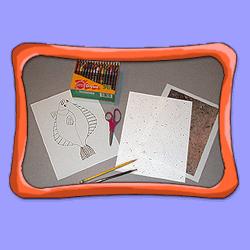Source Institutions
Source Institutions
Add to list Go to activity
Activity link broken? See if it's at the internet archive

In this activity about camouflage, learners create a model that shows how a flounder is able to blend into a variety of environments. Learners will also explore predator/prey behavior, other sea creatures that blend in to their surroundings, chromatophores, and why human skin can't change color.
- Under 5 minutes
- 30 to 45 minutes
- 1 cent - $1 per student
- Ages 6 - 11
- Activity, Model
- English
Quick Guide
Materials List (per student)
- flounder drawing
- seafloor background drawing (color printout)
- seafloor background drawing (black and white printout)
- scissors
- crayons or colored pencils
- sandpaper, sand, pebbles, fabric, buttons and other materials to create a model of the seafloor (optional)
- blue cellophane (optional)
Subjects
-
Earth and Space Science
-
Earth Structure
- Oceans and Water
-
Earth Structure
-
Life Sciences
-
Cells
- Cell Structure and Function
-
Diversity of Life
- Animals
-
Ecology
- Ecosystems
-
Human Body
- Muscles and Skin
-
Cells
-
Physical Sciences
-
Vibration and Waves
- Light and Optics
-
Light and Optics
- Sunlight and Color
-
Vibration and Waves
Informal Categories
- Animals
- Arts and Crafts
- Model Building
- Nature and Environment
Audience
To use this activity, learners need to:
- see
- see color
- touch
Learning styles supported:
- Involves hands-on or lab activities
Other
This resource is part of:
Access Rights:
- Free access
By:
Source Collection
- Ology
Rights:
- All rights reserved, American Museum of Natural History,
